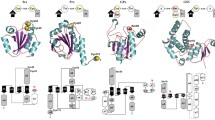Abstract.
For three decades, oxidative stress and the role of reactive oxygen species in biology have been extensively studied. Recently, a new interest in these areas has emerged with the discovery of superoxide reductases, a family of familiar bacterial metalloenzymes whose heretofore unknown function has now been apparently revealed. In a series of experiments utilizing genetic, molecular biological, and biochemical methods, these enzymes have been shown to be physiologically competent at removing superoxide. The role of these enzymes and their biological relationship to the well-known superoxide dismutases is discussed.
Similar content being viewed by others
Author information
Authors and Affiliations
Additional information
Electronic Publication
Rights and permissions
About this article
Cite this article
Auchère, F., Rusnak, F. What is the ultimate fate of superoxide anion in vivo?. J Biol Inorg Chem 7, 664–667 (2002). https://doi.org/10.1007/s00775-002-0362-2
Received:
Accepted:
Published:
Issue Date:
DOI: https://doi.org/10.1007/s00775-002-0362-2




